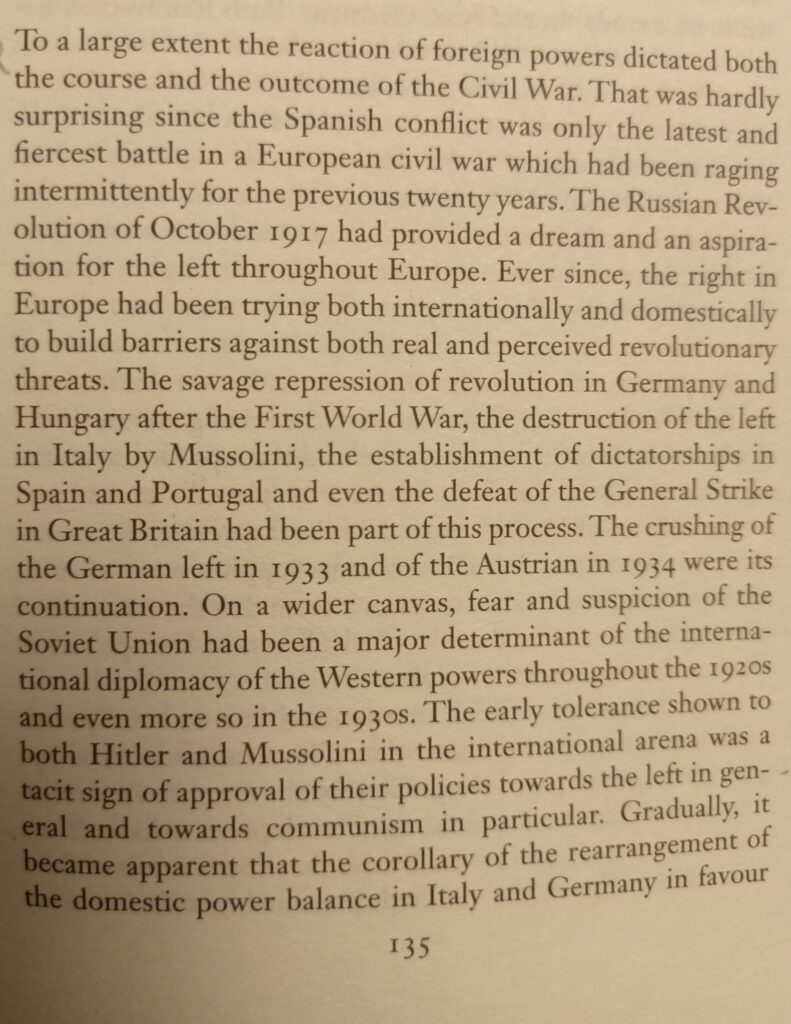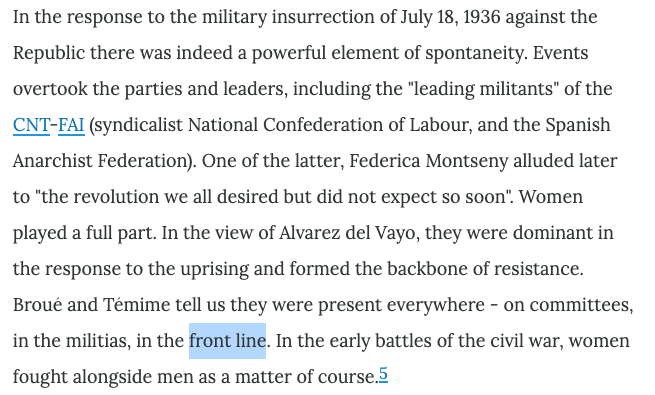- Timeline
- Who fought who?
- General Resources
- Why did the Republicans lose?
- Why did the Nationalists win?
- Foreign Powers
- Human and Economic Resources
- Ideology
- Women
- Guerrilla Warfare
Timeline
Republicans
According to Michael Siedman, the Republicans outnumbered the Nationalists by ten to one at the outbreak of war. This was reduced to four to one by 1937.
- Republicans, or loyalists,
- A Popular Front composed of liberals, Socialists, Trotskyites, Stalinists (both Communists but also rivals), and anarchists.
- CNT – anarchist labour union
- UGT – main Spanish trade union
- PSOE – Socialist political party
- Armed Forces – some remained loyal to the Republic.
- International Brigade
- Basque and Catalan nationalists
Nationalists
- Majority of the Armed Forces
- Africanistas (Spanish Foreign Legion)
- Italian, German and Portuguese governments
- CEDA – Catholic and Conservative political party
Who fought who?
General Resources
Francisco Franco Part 1: Spain’s Buried Past
Francisco Franco Part 2: The ‘Little Major’ Terrorises Africa
Francisco Franco Part 3: The Civil War and the White Terror
Why did the Republicans lose?
- Why did the ‘Republicans’ lose?
- Non-intervention
- Britain wanted Franco to win the war initially. It had business interests in Spain and thought that the Nationalists would bring stability to the country to protect them. They also did not want to take part in another European war, the memories of the First World War were still vivid in British society. As part of their support for Franco, they may have given aid to Portugal, their long-term ally, whose government was sympathetic to the Nationalists.
- Paul Preston argues that had Britain entered into the Spanish Civil War on the side of the Republicans, and Winston Churchil the future prime minister argued they should, it would have had a huge impact on how much Italy and Germany were prepared to fight (the British Royal Navy could stop many Italian supplies for example) and may have prevented the Second World War.
- Soviet intervention
- Non-intervention
- Disunity

- International Brigade
Why did the Nationalists win?
- Why did the Nationalists win?
- According to Helen Graham, albeit looking back on the war, it can be argued that it was inevitable that the Nationalists would win the war. They had the support of Italy, Germany and Portugal and had the guarantee that Britain and France would not help the Republicans. the only surprise was that the Left were able to sustain the war for so long.
- Spanish Army
- The bulk of the Spanish Army was on the side of the Nationalists.
- Africanistas
- Foreign Powers
- Germany wanted to assist a nationalist cause in a short war, experimenting with its weaponry at the same time. Its aerial assistance was instrumental in achieving air superiority over the Republicans during the war. Guernica
- Paul Preston argues that Italy and Germany entered into the war to weaken Britain and France. In this, they were successful.
- Unity
- General Franco was eventually in charge of the Nationalist forces. According to Paul Preston, he had his own press officer even before he was the leader, putting out propaganda that he was directing the war. He was very ambitious and ensured there was only one leader. This alienated some on the right, Gil Robles for example, but it ensured stability and efficiency.
- Professors Helen Graham and Mary Vincent argue that there is a religious crusade for the Nationalists. They fight to protect the Catholic Church (it had been attacked by some Leftist forces since 1931) and this helps create a degree of unity amongst their forces.
- Portugal – Portugal and the Spanish Civil War
- Red Terror – Spain: Remembering the forgotten Red Terror
Foreign Powers
Communism and the USSR
by Lisa A. Kirschenbaum, International Communism and the Spanish Civil War
- The USSR was seen as a safe haven for Spanish communists to leave their children so they could fight the war, Rivera Sanchez was one such mother who did this.
- There were clandestine (secret) training schools for international revolutionaries in Moscow. These would provide recruits for the International Brigade, aimed at spreading the ideology of communism and to understand the world with Soviet eyes. The most prestigious was the Lenin School. The Bolsheviks wanted to remake the world and communism was the ideology to do this. Comintern (Communist International) was the organisation in charge of this operation – it had sixty-five parties across six continents by 1935.
- The 1936 coup d’etat could have been defeated in its infancy if it did not receive support from Hitler and Mussolini – fourteen thousand Spanish and Moroccan troops were transported (initially trapped there) across the Straits of Gibraltar to Spain by Italian and German aircraft.
- These troops used similar tactics to those used in Morocco and were aided by up to seventy thousand Italian soldiers, hundreds of artillery pieces, tanks, and aircraft. In particular, the Condor Legion, bombers from Wehrmacht, gave air support and bombed targets such as Guernica to aid the Nationalists.
- During the war, the USSR was seen to be the saviour of democracy (Soviet propaganda therefore effective), standing up to the fascists. This helped attract support for the International Brigade.
- Republicans accepted Soviet aid reluctantly, they knew the West would not approve and be less likely to offer support themselves.
- Arguably, the USSR did not want to prevent the Nationalists taking control of Spain, but instead wanted a communist country.

Human and Economic Resources
- As stated earlier, the USSR gave the Republicans military aid. This was generally weaponry but there were also military personnel too. However, the weapons varied in quality, from a small number of excellent tanks to virtually obsolete rifles from the Russo-Japanese and First World wars. As there were so many different types of weaponry, acquiring the correct ammunition was far from easy and this limited their use.
Ideology
- The Left was generally disunited during the war whereas the Right were not. For example, the Left comprised the anarchists, communists, socialists and the independence movements. The anarchists followed the ideas of Mikhail Bakunin.

- This meant that they did not accept any influence from Comintern or the communists as they preached centralised control.
Women
Women are generally ignored in warfare but they were prominent in the Spanish Civil War.
- Prior to the war, their work was hard and poorly paid. Their wages were lower than that of men, although the figures differed according to the regions.
- The Republican constitution of 1931 brought equal voting (aged 23). Divorce became legal and more women took part in politics.
- During the early stages of the Revolution, women fought alongside men.
- Their wages were still generally lower than men’s but they did increase. Moreover, families received a ‘family wage’ so that they did not always have to work.
- Women took places in committees too, although few actually had as much influence as the men.
- They also began to wear trousers, perhaps a symbol of freedom, and helped collect for International Red Help (an organisation set up by the USSR to deliver aid).
- By the end of September 1936 Mujeres Libres or Free Women had seven Labour Sections – Transport, Public Services, Nursing, Clothing, Mobile Brigades for non-specialists, and brigades able to substitute for men needed in the war. This led to greater calls for emancipation and health care.
- Women continued to fight in the war, for example a women’s battalion fought (on the Republican side) before Segovia Bridge, during the Battle for Madrid, in 1936. These groups were called the milicianas. Women also fought for Nationalists too.
- However, many female units were trained for the defence of cities rather than for offensive actions. This is partly disputed by Lisa Lines, historian of the Spanish Civil War, who cites women who had fought and died on the front line. These milicianas fought until 1937, Lina Odena being amongst the most prominent. She led a militia group and was also a journalist, captured by Falange fighters in 1936, she killed herself rather than be executed.
- However, according to Liz Willis,

- Women were heavily involved in ensuring their families were safe, especially as men were generally involved in the war. Both sides allowed the movement of families away from the fighting.
Women in the Spanish Revolution
Guerrilla Warfare
